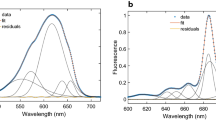Abstract
Fluorescence polarization of photosystem II particles treated with trypsin and incubated with high salt-medium (2M NaCl) was investigated. The presence of atrazine and TMPD in normal and salt-washed particles induced a decrease in the polarization ratios. Similar results were obtained at low concentrations of trypsin. On the basis of our observations we suggest that the presence of these perturbing agents causes a reorganisation of the membrane components and alters pigment-pigment and pigment-protein interactions. The results of fluorescence polarization demonstrate trypsin entry into the membrane after the digestion of the peripheral proteins.
Similar content being viewed by others
Abbreviations
- Chl:
-
chlorophyll
- Mes:
-
2-(N-morpholino)-ethanesulfonic acid
- OEC:
-
oxygen evolving complex
- PS II:
-
photosystem II
- TMPD:
-
N, N, N′
- N′:
-
tetramethyl-p-phenyl-enediamine
- DPH:
-
1, 6-diphenyl-1, 3, 5-hexatriene
References
Breton J and Vermeglio A (1982) Orientation of photosynthetic pigments in vivo. In: Govindjee (ed.) Photosynthesis—Energy Conversion by Plants and Bacteria, Vol. 1, pp 153–194. New York: Academic Press
Breton J (1984) Orientation of photosynthetic pigments in vivo. Structural and functional aspects. In: Sybesma C (ed.) Advances in Photosynthesis Research, Vol. 3, pp 11–17. The Hague: Martinus Nijhoff/Dr W. Junk
Yamamoto Y and Nishimura M (1983) Organization of the O2-evolution enzyme complex in a highly purified O2-evolving photosystem II preparation. In: Inoue Yet al. (eds) The oxygen evolving system of photosynthesis, pp 229–238. Japan: Academic Press
Ghanotakis DF, Topper JN and Yocum CF (1984) Structural organization of the oxidizing side of photosystem II. Exogenous reductants reduce and destroy the Mn-complex in photosystem II membrane depleted of the 17 and 23 kDa polypeptides. Biochim. Biophys Acta 767: 524–531
Berthold DA, Babcock GT and Yocum CF (1981) A highly resolved oxygen evolving photosystem II preparation from spinach thylakoid membranes. FEBS Lett 134: 231–234
Wong D and Govindjee (1981) Action spectra of cation effects on the fluorescence polarization and intensity in thylakoids at room temperature. Photochem Photobiol 33: 103–108
Vacek K, Wong D and Govindjee (1977) Absorption and fluorescence properties of highly enriched reaction center particles of photosystem I and of artificial systems. Photochem Photobiol 26: 269–276
Wong D and Govindjee (1979) Antagonistic effects of mono — and divalent cations on polarization of chlorophyll fluorescence in thylakoids and changes in excitation energy transfer. FEBS Lett 97: 373–377
Murata N, Miyao M and Kuwabara T (1983) Organisation of the photosynthetic oxygen evolution system. In: Inoue Yet al. (eds) The oxygen evolving system of photosynthesis, pp 213–222. Japan: Academic Press
Velthuys B (1983) Spectrophotometric methods of probing the donor side of photosystem II. In: Inoue Yet al. (eds) The oxygen evolving system of photosynthesis, pp 83–90. Japan: Academic Press
Author information
Authors and Affiliations
Rights and permissions
About this article
Cite this article
Paliwal, R., Singhal, G.S. Fluorescence polarization of trypsin digested photosystem II membranes. Photosynth Res 12, 83–90 (1987). https://doi.org/10.1007/BF00019153
Received:
Accepted:
Issue Date:
DOI: https://doi.org/10.1007/BF00019153




